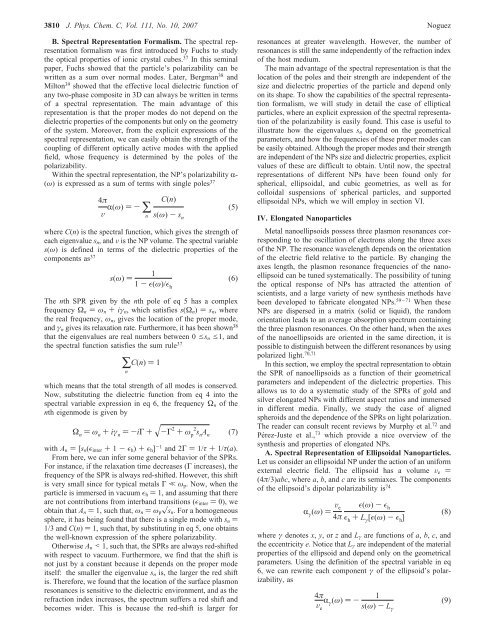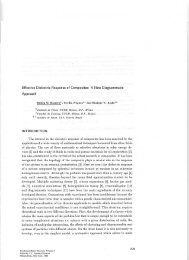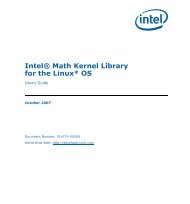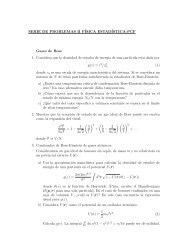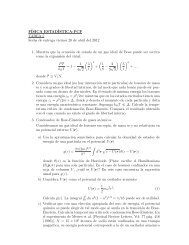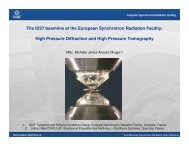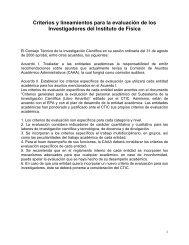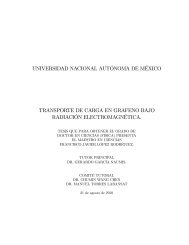Surface Plasmons on Metal Nanoparticles - UNAM
Surface Plasmons on Metal Nanoparticles - UNAM
Surface Plasmons on Metal Nanoparticles - UNAM
Create successful ePaper yourself
Turn your PDF publications into a flip-book with our unique Google optimized e-Paper software.
3810 J. Phys. Chem. C, Vol. 111, No. 10, 2007 NoguezB. Spectral Representati<strong>on</strong> Formalism. The spectral representati<strong>on</strong>formalism was first introduced by Fuchs to studythe optical properties of i<strong>on</strong>ic crystal cubes. 37 In this seminalpaper, Fuchs showed that the particle’s polarizability can bewritten as a sum over normal modes. Later, Bergman 38 andMilt<strong>on</strong> 39 showed that the effective local dielectric functi<strong>on</strong> ofany two-phase composite in 3D can always be written in termsof a spectral representati<strong>on</strong>. The main advantage of thisrepresentati<strong>on</strong> is that the proper modes do not depend <strong>on</strong> thedielectric properties of the comp<strong>on</strong>ents but <strong>on</strong>ly <strong>on</strong> the geometryof the system. Moreover, from the explicit expressi<strong>on</strong>s of thespectral representati<strong>on</strong>, we can easily obtain the strength of thecoupling of different optically active modes with the appliedfield, whose frequency is determined by the poles of thepolarizability.Within the spectral representati<strong>on</strong>, the NP’s polarizability R-(ω) is expressed as a sum of terms with single poles 374πV R(ω) )- ∑nC(n)s(ω) - s n(5)where C(n) is the spectral functi<strong>on</strong>, which gives the strength ofeach eigenvalue s n , and V is the NP volume. The spectral variables(ω) is defined in terms of the dielectric properties of thecomp<strong>on</strong>ents as 371s(ω) )(6)1 - ɛ(ω)/ɛ hThe nth SPR given by the nth pole of eq 5 has a complexfrequency Ω n ) ω n + iγ n , which satisfies s(Ω n ) ) s n , wherethe real frequency, ω n , gives the locati<strong>on</strong> of the proper mode,and γ n gives its relaxati<strong>on</strong> rate. Furthermore, it has been shown 38that the eigenvalues are real numbers between 0 es n e1, andthe spectral functi<strong>on</strong> satisfies the sum rule 37∑C(n) ) 1nwhich means that the total strength of all modes is c<strong>on</strong>served.Now, substituting the dielectric functi<strong>on</strong> from eq 4 into thespectral variable expressi<strong>on</strong> in eq 6, the frequency Ω n of thenth eigenmode is given byΩ n ) ω n + iγ n )-iΓ + -Γ 2 + ω p 2 s n A n (7)with A n ) [s n (ɛ inter + 1 - ɛ h ) + ɛ h ] -1 and 2Γ ) 1/τ + 1/τ(a).From here, we can infer some general behavior of the SPRs.For instance, if the relaxati<strong>on</strong> time decreases (Γ increases), thefrequency of the SPR is always red-shifted. However, this shiftis very small since for typical metals Γ , ω p . Now, when theparticle is immersed in vacuum ɛ h ) 1, and assuming that thereare not c<strong>on</strong>tributi<strong>on</strong>s from interband transiti<strong>on</strong>s (ɛ inter ) 0), weobtain that A n ) 1, such that, ω n ) ω p s n . For a homogeneoussphere, it has being found that there is a single mode with s n )1/3 and C(n) ) 1, such that, by substituting in eq 5, <strong>on</strong>e obtainsthe well-known expressi<strong>on</strong> of the sphere polarizability.Otherwise A n < 1, such that, the SPRs are always red-shiftedwith respect to vacuum. Furthermore, we find that the shift isnot just by a c<strong>on</strong>stant because it depends <strong>on</strong> the proper modeitself: the smaller the eigenvalue s n is, the larger the red shiftis. Therefore, we found that the locati<strong>on</strong> of the surface plasm<strong>on</strong>res<strong>on</strong>ances is sensitive to the dielectric envir<strong>on</strong>ment, and as therefracti<strong>on</strong> index increases, the spectrum suffers a red shift andbecomes wider. This is because the red-shift is larger forres<strong>on</strong>ances at greater wavelength. However, the number ofres<strong>on</strong>ances is still the same independently of the refracti<strong>on</strong> indexof the host medium.The main advantage of the spectral representati<strong>on</strong> is that thelocati<strong>on</strong> of the poles and their strength are independent of thesize and dielectric properties of the particle and depend <strong>on</strong>ly<strong>on</strong> its shape. To show the capabilities of the spectral representati<strong>on</strong>formalism, we will study in detail the case of ellipticalparticles, where an explicit expressi<strong>on</strong> of the spectral representati<strong>on</strong>of the polarizability is easily found. This case is useful toillustrate how the eigenvalues s n depend <strong>on</strong> the geometricalparameters, and how the frequencies of these proper modes canbe easily obtained. Although the proper modes and their strengthare independent of the NPs size and dielectric properties, explicitvalues of these are difficult to obtain. Until now, the spectralrepresentati<strong>on</strong>s of different NPs have been found <strong>on</strong>ly forspherical, ellipsoidal, and cubic geometries, as well as forcolloidal suspensi<strong>on</strong>s of spherical particles, and supportedellipsoidal NPs, which we will employ in secti<strong>on</strong> VI.IV. El<strong>on</strong>gated <strong>Nanoparticles</strong><strong>Metal</strong> nanoellipsoids possess three plasm<strong>on</strong> res<strong>on</strong>ances corresp<strong>on</strong>dingto the oscillati<strong>on</strong> of electr<strong>on</strong>s al<strong>on</strong>g the three axesof the NP. The res<strong>on</strong>ance wavelength depends <strong>on</strong> the orientati<strong>on</strong>of the electric field relative to the particle. By changing theaxes length, the plasm<strong>on</strong> res<strong>on</strong>ance frequencies of the nanoellipsoidcan be tuned systematically. The possibility of tuningthe optical resp<strong>on</strong>se of NPs has attracted the attenti<strong>on</strong> ofscientists, and a large variety of new synthesis methods havebeen developed to fabricate el<strong>on</strong>gated NPs. 59-71 When theseNPs are dispersed in a matrix (solid or liquid), the randomorientati<strong>on</strong> leads to an average absorpti<strong>on</strong> spectrum c<strong>on</strong>tainingthe three plasm<strong>on</strong> res<strong>on</strong>ances. On the other hand, when the axesof the nanoellipsoids are oriented in the same directi<strong>on</strong>, it ispossible to distinguish between the different res<strong>on</strong>ances by usingpolarized light. 70,71In this secti<strong>on</strong>, we employ the spectral representati<strong>on</strong> to obtainthe SPR of nanoellipsoids as a functi<strong>on</strong> of their geometricalparameters and independent of the dielectric properties. Thisallows us to do a systematic study of the SPRs of gold andsilver el<strong>on</strong>gated NPs with different aspect ratios and immersedin different media. Finally, we study the case of alignedspheroids and the dependence of the SPRs <strong>on</strong> light polarizati<strong>on</strong>.The reader can c<strong>on</strong>sult recent reviews by Murphy et al. 72 andPérez-Juste et al., 73 which provide a nice overview of thesynthesis and properties of el<strong>on</strong>gated NPs.A. Spectral Representati<strong>on</strong> of Ellipsoidal <strong>Nanoparticles</strong>.Let us c<strong>on</strong>sider an ellipsoidal NP under the acti<strong>on</strong> of an uniformexternal electric field. The ellipsoid has a volume V e )(4π/3)abc, where a, b, and c are its semiaxes. The comp<strong>on</strong>entsof the ellipsoid’s dipolar polarizability is 74R γ (ω) ) V e ɛ(ω) - ɛ h4π ɛ h + L γ [ɛ(ω) - ɛ h ]where γ denotes x, y, orz and L γ are functi<strong>on</strong>s of a, b, c, andthe eccentricity e. Notice that L γ are independent of the materialproperties of the ellipsoid and depend <strong>on</strong>ly <strong>on</strong> the geometricalparameters. Using the definiti<strong>on</strong> of the spectral variable in eq6, we can rewrite each comp<strong>on</strong>ent γ of the ellipsoid’s polarizability,as(8)4π1RV γ (ω) )-(9)e s(ω) - L γ


